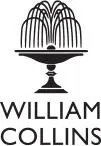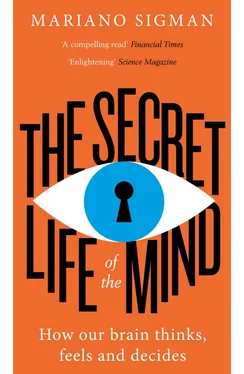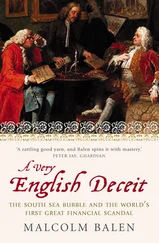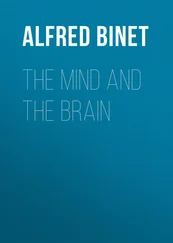
William Collins
An imprint of HarperCollins Publishers
1 London Bridge Street
London SE1 9GF
www.WilliamCollinsBooks.com
This eBook first published in Great Britain by William Collins in 2017
Copyright © 2015 Mariano Sigman
Copyright © 2015, Penguin Random House Grupo Editorial, S. A. Buenos Aires
Copyright © 2015, Penguin Random House Grupo Editorial,
S. A. U. Travessera de Gracia, 47–49. 08021 Barcelona
English translation © Mariano Sigman 2017
Text on p.84 from The Simpsons, Season 2 Episode 12, ‘The Way We Was’, written by Al Jean & Mike Reiss and Sam Simon, originally aired January 31, 1991.
© Fox Broadcasting Company. All rights reserved.
Mariano Sigman asserts the moral right to be identified as the author of this work
A catalogue record for this book is available from the British Library
All rights reserved under International and Pan-American Copyright Conventions. By payment of the required fees, you have been granted the non-exclusive, non-transferable right to access and read the text of this e-book on-screen. No part of this text may be reproduced, transmitted, down-loaded, decompiled, reverse engineered, or stored in or introduced into any information storage and retrieval system, in any form or by any means, whether electronic or mechanical, now known or hereinafter invented, without the express written permission of HarperCollins
Source ISBN: 9780008210922
Ebook Edition © June 2017 ISBN: 9780008210939
Version: 2018-05-30
From the international reviews of The Secret Life of the Mind :
‘To read minds nowadays, one doesn’t need to be a magician or clairvoyant. As science takes leaps and bounds towards understanding the mysteries of consciousness, Mariano Sigman, one of the most notable neuroscientists of today, has written a book on just this subject’
Revista Nueva
‘The brain is the star of this book, with chapters focusing on its characteristics throughout childhood and youth, identity, decision-making, consciousness, education and its capacity to transform itself. In exploring the psychological element of neuroscience, Mariano Sigman tells the story of the human mind as a journey through some of the least travelled paths of mankind … A wonderful read’
La Nacion
‘Sigman confirms that although we are capable of detecting and manipulating consciousness, science is still not able to physically break it down. The idea of the mind as a tabula rasa is only one of many erroneous notions that Sigman’s brilliant book helps to correct’
El Cultural, El Mundo
‘What makes The Secret Life of the Mind a great read is Sigman’s solid capacity as a scientific storyteller’
Clarin
‘In his latest publication, Sigman takes readers on a new journey into their own minds. This introspective journey attempts to access the deepest parts of our brain, where maybe even the secret of human essence lies’
RTVE
‘What differentiates The Secret Life of the Mind from other books about the mind is that it takes on neuroscience from a psychological point of view, as well as taking into account psychoanalysis, behavioural economics and philosophy’
Nosotras
‘Sigman takes us on an entertaining journey through the brain to show us how we make decisions, how we feel and how we think’
El Confidencial
‘ The Secret Life of the Mind proposes a journey similar to that undertaken by Carl Sagan in Cosmos aboard his vessel of knowledge, but in this case through our inner universe’
Federico Kukso, Le Monde diplomatique
To Milo and Noah
Contents
Cover
Title Page
Copyright
Praise
Dedication
Introduction
1: The origin of thought
How do babies think and communicate, and how can we understand them better?
The genesis of concepts
Atrophied and persistent synaesthesias
The mirror between perception and action
Piaget’s mistake!
The executive system
The secret in their eyes
Development of attention
The language instinct
Mother tongue
The children of Babel
A conjecturing machine
The good, the bad and the ugly
He who robs a thief …
The colour of a jersey, strawberry or chocolate
Émile and Minerva’s owl
I, me, mine and other permutations by George
Transactions in the playground, or the origin of commerce and theft
Jacques, innatism, genes, biology, culture and an image
2: The fuzzy borders of identity
What defines our choices and allows us to trust other people and our own decisions?
Churchill, Turing and his labyrinth
Turing’s brain
Turing in the supermarket
The tell-tale heart
The body in the casino and at the chessboard
Rational deliberation or hunches?
Sniffing out love
Believing, knowing, trusting
Confidence: flaws and signatures
The nature of optimists
Odysseus and the consortium we belong to
Flaws in confidence
Others’ gazes
The inner battles that make us who we are
The chemistry and culture of confidence
The seeds of corruption
The persistence of social trust
To sum up …
3: The machine that constructs reality
How does consciousness emerge in the brain and how are we governed by our unconscious?
Lavoisier, the heat of consciousness
Pyschology in the prehistory of neuroscience
Freud working in the dark
Free will gets up off the couch
The interpreter of consciousness
‘Performiments’: freedom of expression
The prelude to consciousness
In short: the circle of consciousness
The physiology of awareness
Reading consciousness
Observing the imagination
Shades of consciousness
Do babies have consciousness?
4: Voyages of consciousness (or consciousness tripping)
What happens in the brain as we dream; is it possible for us to decipher, control and manipulate our dreams?
Altered states of consciousness
Nocturnal elephants
The uroboros plot
Deciphering dreams
Daydreams
Lucid dreaming
Voyages of consciousness
The factory of beatitude
The cannabic frontier
Towards a positive pharmacology
The consciousness of Mr X
The lysergic repertoire
Hoffman’s dream
The past and the future of consciousness
The future of consciousness: is there a limit to mind-reading?
5: The brain is constantly transforming
What makes our brain more or less predisposed to change?
Virtue, oblivion, learning, and memory
The universals of human thought
The illusion of discovery
Learning through scaffolding
Effort and talent
Ways of learning
The OK threshold
The history of human virtue
Fighting spirit and talent: Galton’s two errors
The fluorescent carrot
The geniuses of the future
Memory palace
The morphology of form
A monster with slow processors
Our inner cartographers
Fluorescent triangles
The parallel brain and the serial brain
Learning: a bridge between two pathways in the brain
The repertoire of functions: learning is compiling
Automatizing reading
The ecology of alphabets
Читать дальше













